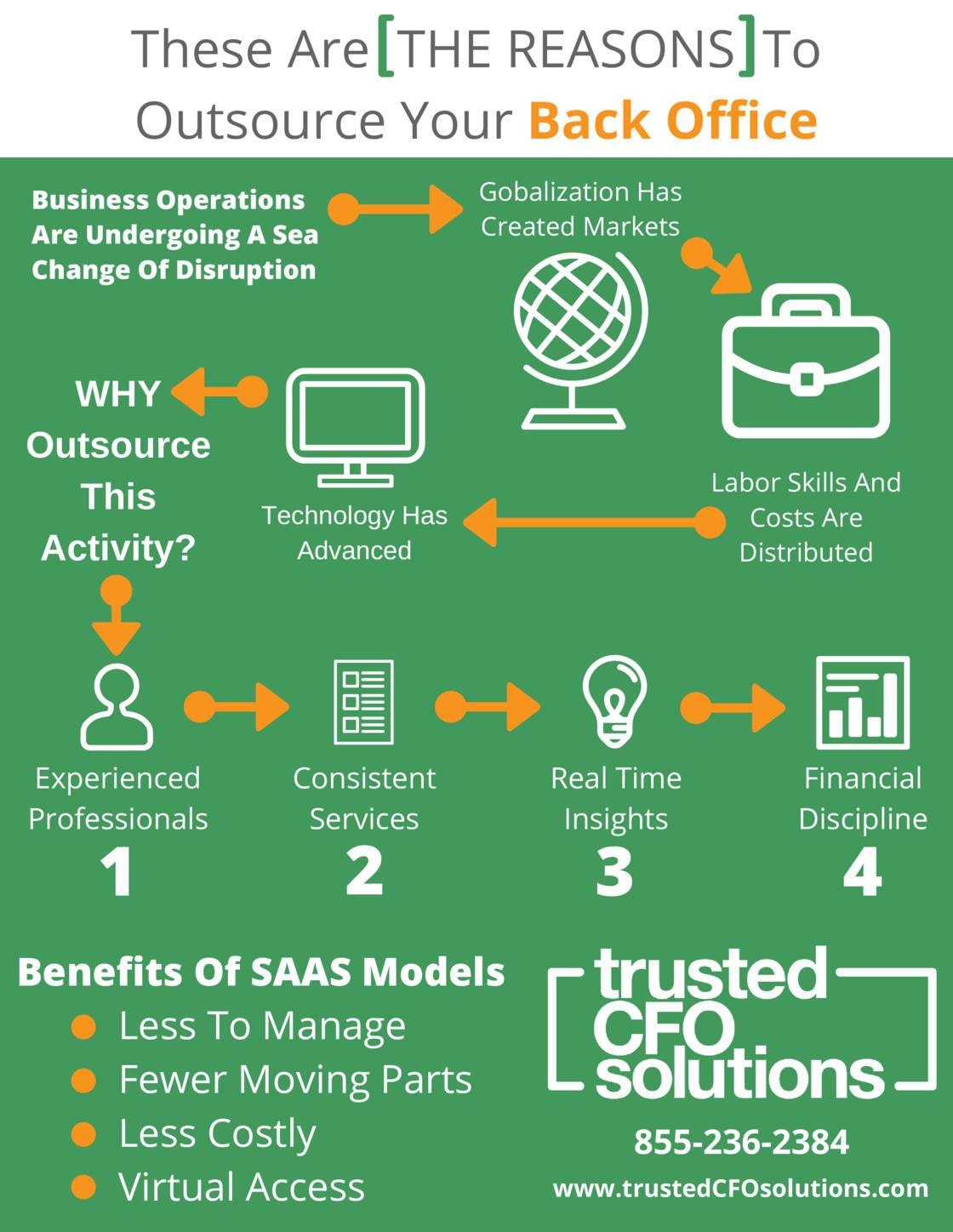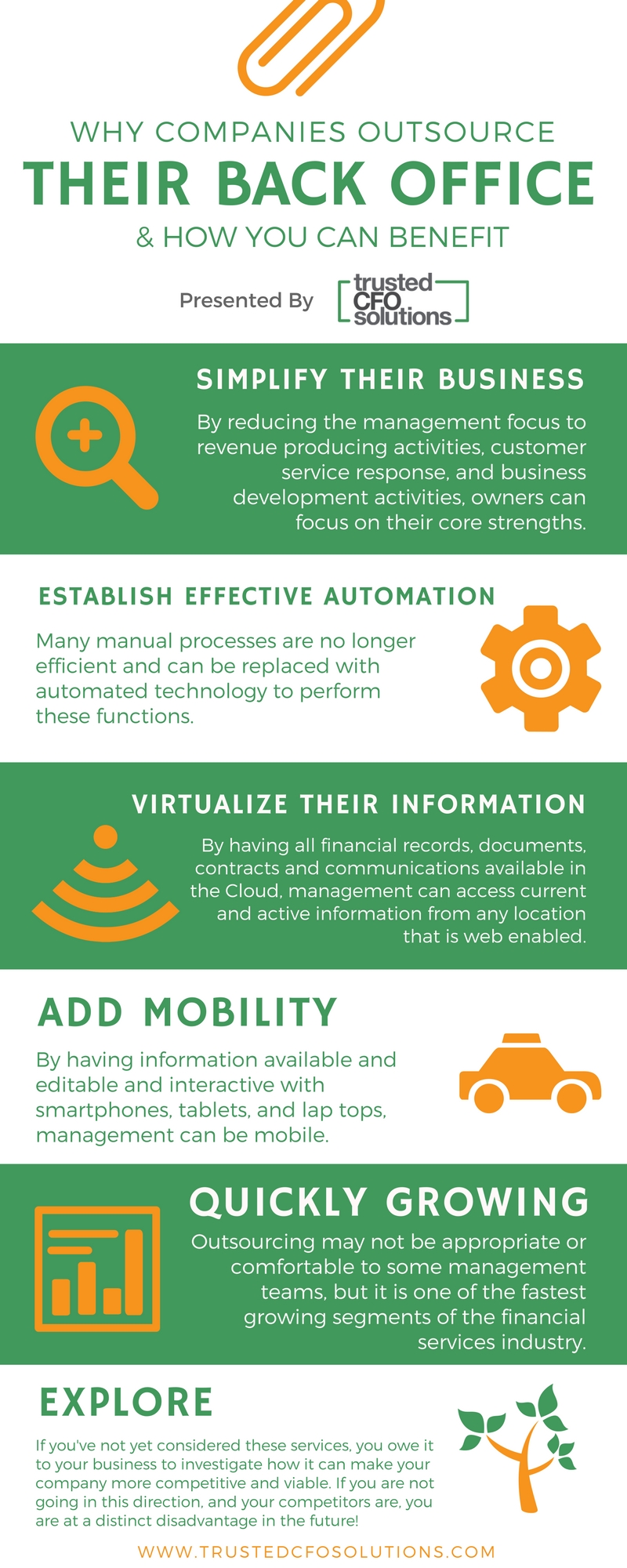
Top Reasons to Outsource Your Back Office, Why Companies Are Making The Shift, And How You Can Benefit
Business operations are undergoing a sea change of disruption caused by many factors.
First, globalization has created markets and demand for almost all products purchased online and delivered by global systems to anywhere for anyone.
Second, labor skills and costs are now distributed around the world, so customer support and administrative activities are now performed by a qualified and educated workforce around the world.
Third, technology has advanced to a point where old traditions of business processes and management are being displaced by information and insights becoming available to owners in real time and on mobile devices. It’s changing the structure of how business organizes.
Back office operations are a bright example of how technology has changed to empower more effective business performance.

Historically, information delivery and financial reporting evolved, led by technology:
1960’s & 1970’s – Time of “Big Iron” – large mainframes used to process information. Required cooling rooms and raised flooring to support process.
1980’s – Mini-computers evolved. Smaller versions of “Big Iron” needed less space and used more flexible software written for the platform.
1990’s – Personal computers developed and early networks created, using internal wiring and low bandwidth connection to process data.
2000’s – Networks of personal computers developed, with smart devices to manage them “on-premise”, beginning the need for IT support staff.
2010’s – “Software as a Service“ (SAAS) processes developed to replace on-premise networks.
The stage is set for current business practices to move to SAAS based models as an advance in effectiveness and efficiency.

In our ever-changing business environments, many businesses are moving towards a revised operating philosophy and execution in order to:
-
1
Simplify Their Business
By reducing the management focus to revenue-producing activities, customer service response, and business development activities, owners can focus on their core strengths.
-
2
Establish Effective Automation
Many manual processes are no longer efficient and can be replaced with automated technology to perform these functions.
-
3
Virtualize Their Information
By having all financial records, documents, contracts, and communications available in the Cloud, management can access current and active information from any location that is web-enabled. Fewer capital expenditures for servers, desktops, applications and IT staff are needed.
-
4
Add Mobility To Virtual
By having information available and editable and interactive with smartphones, tablets, and laptops, management can be mobile.

The major benefits to an operating business of outsourcing this process, once the change in operating process is accepted, would include:
-
A
Adding A New Business Dimension
Virtualizing and creating digital data streams allow you to measure more activities in order to manage more outcomes.
-
B
Performed Assessment & Design
Before a process change occurs, an operations assessment is performed, and the efficiencies identified as a prelude to designing the new environment.
-
C
Implementation Of Your Virtual Environment
In this stage process and duty changes are installed to create real-time information available to management anywhere.
-
D
Scanned Data Is Input Digitally
Vastly reducing requirements to use and file paper documents. They are then accessed and used in a virtual environment.
-
E
New Environment Integration With Your Team
Training, repurposing staff and designing dashboards with key performance indicators occurs.
-
F
Intentional Insight Reviews Are Held With Management
- 1) In-person meetings can occur as needed.
- 2) Virtual Video conferencing sessions occur to review performance, insights and operational effectiveness.
- 3) Meetings hosted by experienced CFO and finance professionals.
-
G
These Insight Reviews Lead To Clear Action Plans
- 1) Areas of concern and/or improvement needed are agreed upon based on our analysis and discussion.
- 2) Assignments to specific individuals for follow-up and outcome responsibility occur.
- 3) Timetables are agreed to perform the assigned tasks.
- 4) Follow up on all parties occur with subsequent meetings of management.

Your Business Deserves These Outcomes From Outsourcing Your Back Office
- Less To Manage – replacing networks equipment, internal applications, and IT staff reduce the management stress of ownership and let the company focus on core revenue activities.
- Fewer Moving Parts – without diverse activities to manage, owners can focus on profitability drivers vs. administrative support activities.
- Less Costly – as technology and outsourced processing replace internal equipment, licensing applications, network administration, and IT staff, total costs of operation decline.
- Virtual Access – SAAS-based models use any browser-connected device for input and output available anywhere, anytime by browser-connected devices.

Why Outsource This Activity?
- Use of experienced professionals that are trained and skilled at SAAS platform and its effective functions.
- The consistency of services prevents worry and management of internal people turnover and retraining.
- Insights developed to assist management in real-time management decisions.
- Financial management discipline added to the management process. Roles and duties of provider include periodic review and development of action plans for improvements added to recurring management activities.
Outsourcing may not be appropriate or comfortable to some management teams, but it is one of the fastest-growing segments of the financial services industry.
If you have not considered these services in the past, you owe it to your business to inquire and investigate how it might make you more competitive and viable in your decision-making. If you are not going in this direction, and your competitors are, you are at a distinct disadvantage in the future!
In summary, the business world has changed for the better. Companies embracing and integrating these changes will rise above their competitors and succeed in an ever-increasing competitive world.
Click here to explore our back-office accounting services
Click Here To Download This Article As A PDF

Download This Infographic As A PDF
Download This Infographic As A PDF
About The Author
 Stephen Gross is a big picture thinker and connector, with 40 years of rich and diverse experience in the C.P.A., business consulting, and venture capital worlds. Steve was an early adopter and evangelist of cloud-based accounting, as well as the concept of a virtual C.F.O. or Controller as a method of outsourcing the position in small businesses and startups. Steve brings his extensive experience as an entrepreneur, board member, and business advisor to his role at TCFOS. Learn More About Steve…
Stephen Gross is a big picture thinker and connector, with 40 years of rich and diverse experience in the C.P.A., business consulting, and venture capital worlds. Steve was an early adopter and evangelist of cloud-based accounting, as well as the concept of a virtual C.F.O. or Controller as a method of outsourcing the position in small businesses and startups. Steve brings his extensive experience as an entrepreneur, board member, and business advisor to his role at TCFOS. Learn More About Steve…
Tags
Outgrowing Quickbooks?
Say goodbye to spreadsheet reporting and manual consolidations and start using a cloud-based financial management system.
Related Content
Wrap-Up: Reimagine Your Month-End Close with Sage Intacct
Best Practices to Perfect Your Month-End Close With Sage Intacct
Decoding the Challenges of the Month-End Close
Fast-Track Your Financials: Techniques to Slash Your Month-End Close
Take Control of the Month-End Close: A Checklist for Success
Managing Your Accounts Payable: A Guide for Small Business Owners
© Trusted CFO Solutions.







